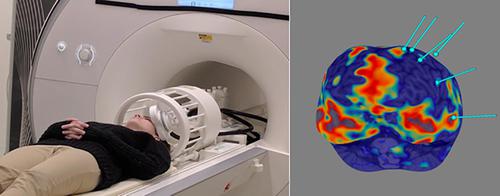当前位置:
X-MOL 学术
›
WIREs Cogn. Sci.
›
论文详情
Our official English website, www.x-mol.net, welcomes your feedback! (Note: you will need to create a separate account there.)
Combining transcranial magnetic stimulation with functional magnetic resonance imaging for probing and modulating neural circuits relevant to affective disorders
WIREs Cognitive Science ( IF 3.9 ) Pub Date : 2021-01-19 , DOI: 10.1002/wcs.1553 Desmond J Oathes 1 , Nicholas L Balderston 1 , Konrad P Kording 2, 3 , Joseph A DeLuisi 1 , Gianna M Perez 1 , John D Medaglia 4, 5, 6 , Yong Fan 7 , Romain J Duprat 1 , Theodore D Satterthwaite 8 , Yvette I Sheline 1 , Kristin A Linn 1, 7, 9
WIREs Cognitive Science ( IF 3.9 ) Pub Date : 2021-01-19 , DOI: 10.1002/wcs.1553 Desmond J Oathes 1 , Nicholas L Balderston 1 , Konrad P Kording 2, 3 , Joseph A DeLuisi 1 , Gianna M Perez 1 , John D Medaglia 4, 5, 6 , Yong Fan 7 , Romain J Duprat 1 , Theodore D Satterthwaite 8 , Yvette I Sheline 1 , Kristin A Linn 1, 7, 9
Affiliation

|
Combining transcranial magnetic stimulation (TMS) with functional magnetic resonance imaging offers an unprecedented tool for studying how brain networks interact in vivo and how repetitive trains of TMS modulate those networks among patients diagnosed with affective disorders. TMS compliments neuroimaging by allowing the interrogation of causal control among brain circuits. Together with TMS, neuroimaging can provide valuable insight into the mechanisms underlying treatment effects and downstream circuit communication. Here we provide a background of the method, review relevant study designs, consider methodological and equipment options, and provide statistical recommendations. We conclude by describing emerging approaches that will extend these tools into exciting new applications.
中文翻译:

将经颅磁刺激与功能性磁共振成像相结合,用于探测和调节与情感障碍相关的神经回路
将经颅磁刺激 (TMS) 与功能性磁共振成像相结合,为研究大脑网络如何在体内相互作用以及 TMS 的重复序列如何在被诊断患有情感障碍的患者中调节这些网络提供了一种前所未有的工具。TMS 通过允许询问大脑回路之间的因果关系来补充神经影像学。与 TMS 一起,神经影像学可以为治疗效果和下游电路通信的机制提供有价值的见解。在这里,我们提供该方法的背景,审查相关的研究设计,考虑方法和设备选项,并提供统计建议。最后,我们描述了将这些工具扩展到令人兴奋的新应用程序的新兴方法。
更新日期:2021-01-19
中文翻译:

将经颅磁刺激与功能性磁共振成像相结合,用于探测和调节与情感障碍相关的神经回路
将经颅磁刺激 (TMS) 与功能性磁共振成像相结合,为研究大脑网络如何在体内相互作用以及 TMS 的重复序列如何在被诊断患有情感障碍的患者中调节这些网络提供了一种前所未有的工具。TMS 通过允许询问大脑回路之间的因果关系来补充神经影像学。与 TMS 一起,神经影像学可以为治疗效果和下游电路通信的机制提供有价值的见解。在这里,我们提供该方法的背景,审查相关的研究设计,考虑方法和设备选项,并提供统计建议。最后,我们描述了将这些工具扩展到令人兴奋的新应用程序的新兴方法。

























 京公网安备 11010802027423号
京公网安备 11010802027423号